Another Timbre TimHarrisonbre
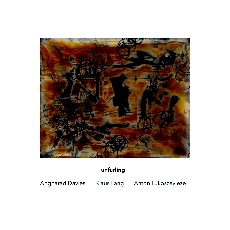
at153 ‘unfurling’
Angharad Davies | Klaus Lang | Anton Lukoszevieze
A 52-minute piece jointly composed and performed by
Angharad Davies (violin), Klaus Lang (harmonium) and Anton Lukoszevieze (cello)
Recorded during a residency at Dai Hall in Huddersfield, March 2020.
Thanks to Ryoko Akama.
Interview with Angharad Davies and Anton Lukoszevieze
conducted by Christian Smith
CS: How did this project come about?
AL: The project was instigated by Simon Reynell (and I think Ryoko Akama as well?) I think it was Simon’s idea for the album. I have played with Angharad over many years in different situations, but never with Klaus, so this opportunity was a blessing for me.
AD: Looking back at an email I received at the end of 2019, Simon Reynell and (yes!) Ryoko Akama were keen to organise a series of concerts in Huddersfield for 2020 and wondered whether I would be interested in doing a joint event with Klaus Lang. I had never met Klaus but had heard his music and knew that a few of my friends had worked with him and spoke very highly of the experience so I was keen to find ways to make this happen. I’ve known Anton for at least 20 years now, in fact my very first concert in London, when I moved here in 2002, was with him and John Lely at Conway Hall on the 14th Feb organised by the LMC. I hold this concert as a significant turning point in the trajectory of where my music was heading at that time.
CS: How did you make decisions about sound world, form, and pitch material? Did you start out playing and improvising right away?
AL: I seem to remember we sat down together for about 10 minutes and discussed some loose structural ideas, which included some archetypal materials and then just started playing together. It really was a very simple and special process for me - it just felt right and each of us was attuned to each other’s sonic worlds and input. It was a complete joy to do.
AD: We started playing immediately despite the cold. The sound world, form, and pitch material emerged as we went along. It was instantaneous and I remember wondering if it was really possible for it to be so easy.
CS: This recording is from a rehearsal the final day of the residency before the concert, how did the two sessions differ?
AL: That is a difficult question to answer, these differences are very subtle. In many ways all recordings were quite similar, the same duration (which was pre-determined), the same order of sections. However, within those parameters a whole different universe emerges with each playing. We were of course improvising, so every ‘version’ would be different but similar - a bit like viewing a complex sculpture from multiple angles.
AD: As I recall they were close, and for me both equally as immersive with regard to structure and flow which made it easy to step into, to be held and be embedded in the piece. What I like in this version from the afternoon rehearsal in particular is that it is void of that framing which a concert inevitably gives, and so what you have here is a very honest, truthful unfolding, feeling our way, a marking, an intimate learning of the piece, and genuine moments of getting lost within.
CS: Yes - it's intriguing how a concert situation inevitably affects the decisions you make as a performer, either by the energy in the room or the literal acoustic change of the space. I have tried to get into the habit myself of recording soundchecks if at all possible, because those runs are usually the most raw and unfiltered. I did have a concert recently where my mic stand fell apart, and that produced unthought of possibilities and playing positions as I held the top half of the mic stand between my legs for the remainder of the performance.
AD: I like those words raw and unfiltered......and yes as you describe those unexpected situations where you are caught up trying to do something else that might not be apparent to the listener and which brings a quality of inhibition that I find very interesting.
CS: Why did you choose ‘unfurling’ as the project name?
AL: I saw the word on the wall in the AME venue in Huddersfield, and I suggested it. I liked the unfurling, unfolding, material aspect of the word which implied for me a process of music emerging and literally unfurling as we played.
Of course music happens in real time, so it seemed logical but poetic to me to use that word.
AD: A slow opening up ……reveal.
CS: I had the same feeling listening to the record. If I can go a bit deeper into my own mental image of the music, I really heard the three of you as a ship on a calm sea, creaking and lightly bobbing, and then every now and then letting the sails down. At the end I really felt as if the ship was disintegrating before my eyes. Could you say that there are three periods of Unfurling within the record? There seem to be clear pitch worlds at each of these points, were they predetermined?
AL: That is a difficult question. I like the fact that you developed this image of the ship and periods of unfurling within your own mind through listening, and I would not like to try to ‘clarify’ our interpretation of our work, and its structural processes, in relation to the title Unfurling. The more solid, pitch-based sections were in 3 parts and the outer/inner more abstract sections merged and emerged into these. No specific pitches or harmonies were ever established, the music is purely improvised. Lastly, referring again to the title of the work, I like to think it is poetic and can work in macro and micro throughout the duration of the music, focusing and defocusing in a continuum.
CS: That's really fascinating, I also have yet to have the experience of 'determining' pitch sets in a context like this. I was just wondering because it sounds very coordinated, but I think that's a testament to how in tune to each other you all were, as well as the magic of improvisation. I’d like to finish by asking you each a question about your individual work. Anton, what kind of work do you do as an artist? What was the material and process of making the artwork for this album?
AL: I work in many different media, mainly photography, video, painting, drawing and collages, but I also compose and make sound installations. The work on the cover is what is known technically as a ‘chromoskedasic silver gelatin photogram print’. It is made first by overpainting a sheet of glass, this covers the entire surface. I then draw by scratching into the surface of the paint. The glass is then overlaid onto a sheet of silver gelatin photographic paper.
The glass and paper are then subjected to different levels of light exposure under an enlarger. I also move the glass plate and make multiple exposures. I then develop the print in different chemicals which react with the silver in the paper’s surface and create colours and hues. The final image is fixed and the print washed and dried.
CS: Angharad, I was listening to some of your other work on Another Timbre, including, ‘ffansion | fancies’ , which you recorded with Tisha Mukarji, and I was hearing a lot of similar sound production techniques that I heard here. What do you like to hear from your instrument, and how have you come to these sounds over the course of your career?
AD: Since the lockdown I’ve had time to revisit some of my archive (especially those recordings that I had good intentions for but they end up buried in my computer or in a box full of indecipherably labelled mini discs or blank CDs without their covers) and it’s interesting reconnecting with some of those lost sounds and wondering why they haven’t been carried forward. A lot was lost with their preparations but there are some techniques that I still carry with me like circular bowing, tremolo, pizzicato and col legno that I find useful to propel the music forward. There are some specific preparations that I use here too, such as the spring and plastic peg that I would have used in ffansion|fancies. But I’m not convinced that I’m lead by what I’d like to hear from my violin, but more by the conditions of being able to place a sound into each context – of it making sense, of it being heard or not heard, its timing….or nowadays placing myself in situations where I’m not falling back on safe familiar sounds but of course finding myself doing exactly that! Ultimately what I want to hear from my violin is so dependent on who I play with or the space I play in.
CS: I love this idea of a history of sounds - how they tell a story of a life. I can place the emersion of a technique or instrumental sound in my memory, producing an almost nostalgic feeling when I come back to it. I have been doing my own small recording projects on my own over the past month, and in the process of overdubbing and layering, I find myself playing in a very new way as I'm literally playing music with different versions of myself through the process. Have you been doing any recording yourself, and how do you see your practice continuing in a post COVID-19 world?
AD: I have actually. The second weekend of lockdown and exactly a month after my last live concert I was asked to play live on skype for Mariam Razei's TOPH which was then broadcast on twitch.tv. Then Tim Parksinson and I did a small show on zoom for Nomi Epstein's curation of Quarantine concerts on the 19th April. I guess they’re not strictly recording because they were intended as live performances but since they are archived they’ve turned into experiments into a new way of recording sound. The first solo was more or less what I would do live, but by the second solo it didn't seem appropriate to just play the violin conventionally so I zoomed right in and started holding the violin in a different way......allowing the visual to lead.....and by playing extremely close to the camera I started to use the table underneath to prop my violin up and using it as a sound source as well. Looking back at both these solos the latency that I have no control over has created a completely different performance to what I actually played!
As for actual recording experiments it’s very early days to comment on what I’m doing and almost impossible to see how my practice will continue post COVID-19. I’ve felt very uncreative and don’t feel like playing my violin. Let’s say though that I’ve been inspired by Adam Bohman’s dictaphone diaries, Ryoko Akama’s daily sculptures and thinking a lot about Emma Hart’s work. And I’ve been grateful for having time to explore my local park most days, and woodland paths that I would never have had the time or made the time to follow, and revelling in the beauty of trees and the overwhelming greenery that I think I can see now all the better for the lack of planes and a turning down of the constant din of traffic along the North Circular.
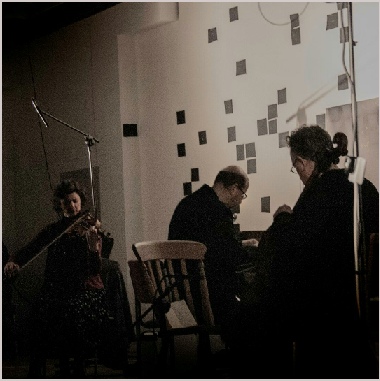
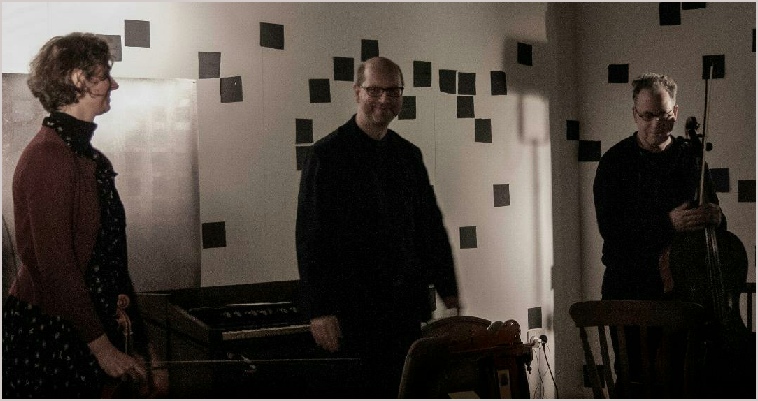
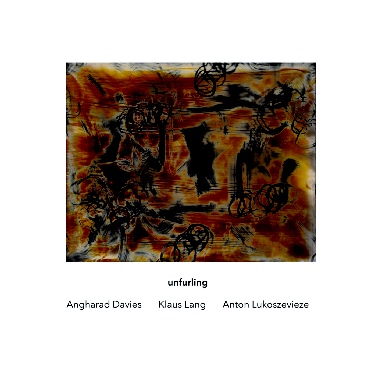
Angharad Davies, Klaus Lang and Anton Lukoszevieze,
in concert at Dai Hall, Huddersfield Photo: Ryoko Akama
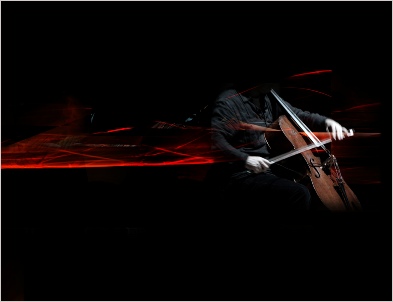
Anton Lukoszevieze